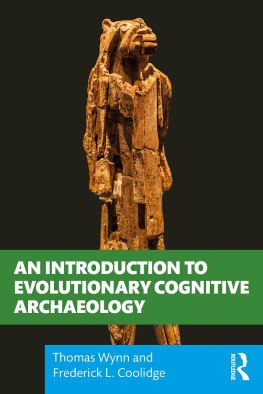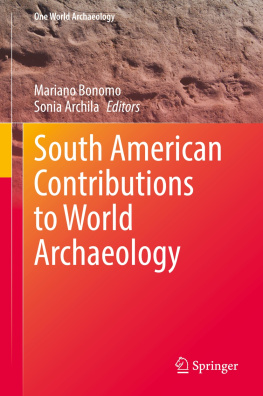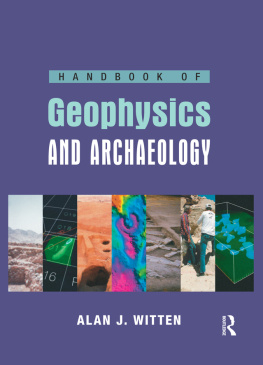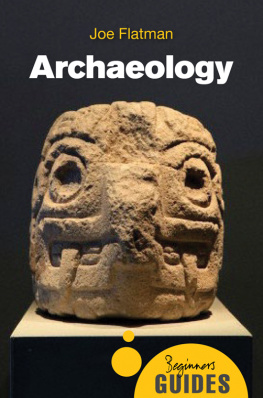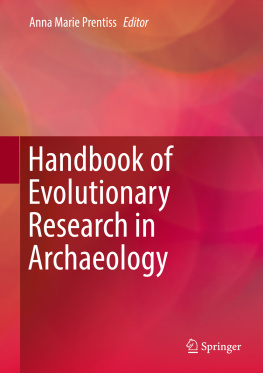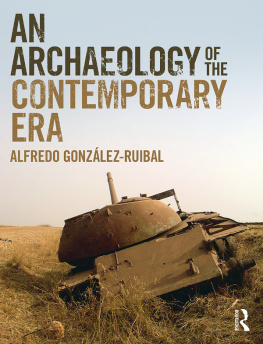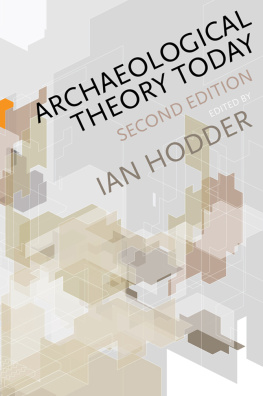Cover
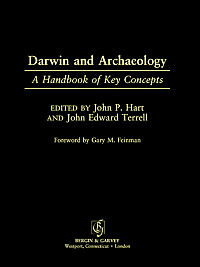
| title | : | Darwin and Archaeology : A Handbook of Key Concepts |
| author | : | Hart, John P.; Terrell, John. |
| publisher | : | Greenwood Publishing Group |
| isbn10 | asin | : | 0897898788 |
| print isbn13 | : | 9780897898782 |
| ebook isbn13 | : | 9780313012945 |
| language | : | English |
| subject | Darwin, Charles,--1809-1882--Contributions in archaeology, Darwin, Charles,--1809-1882, Darwin, Charles,--1809-1882--Et l'archeologie, Human evolution, Evolution (Biology) , Social evolution, Natural selection, Anthropology, Archaeology, Ethnoarchaeology |
| publication date | : | 2002 |
| lcc | : | GN281.D39 2002eb |
| ddc | : | 930.1 |
| subject | : | Darwin, Charles,--1809-1882--Contributions in archaeology, Darwin, Charles,--1809-1882, Darwin, Charles,--1809-1882--Et l'archeologie, Human evolution, Evolution (Biology) , Social evolution, Natural selection, Anthropology, Archaeology, Ethnoarchaeology |
Page i
Darwin and Archaeology
Page ii
This page intentionally left blank.
Page iii
Darwin and Archaeology
A Handbook of Key Concepts
EDITED BY John P. Hart
AND John Edward Terrell
Foreword by Gary M. Feinman

BERGIN & GARVEY
Westport, Connecticut London
Page iv
Library of Congress Cataloging-in-Publication Data
Darwin and archaeology : a handbook of key concepts / edited by John P. Hart and John
Edward Terrell ; foreword by Gary M. Feinman.
p. cm.
Includes bibliographical references and index.
ISBN 0897898788 (alk. paper)ISBN 0897898796 (pbk. : alk. paper)
1. Human evolution. 2. Evolution (Biology) 3. Social evolution. 4. Natural
selection. 5. Anthropology. 6. Archaeology. 7. Ethnoarchaeology. 8. Darwin,
Charles, 18091882Contributions in archaeology. I. Hart, John P. II. Terrell, John.
GN281.D39 2002
930.1dc21 2001043975
British Library Cataloguing in Publication Data is available.
Copyright 2002 by John P. Hart and John Edward Terrell
All rights reserved. No portion of this book may be
reproduced, by any process or technique, without the
express written consent of the publisher.
Library of Congress Catalog Card Number: 2001043975
ISBN: 0-89789-878-8
0-89789-879-6 (pbk.)
First published in 2002
Bergin & Garvey, 88 Post Road West, Westport, CT 06881
An imprint of Greenwood Publishing Group, Inc.
www.greenwood.com
Printed in the United States of America

The paper used in this book complies with the
Permanent Paper Standard issued by the National
Information Standards Organization (Z39.481984).
10 9 8 7 6 5 4 3 2 1
Page v
Contents
Foreword byGary M. Feinman | vii |
Table of Key Words | xv |
| Introduction
John Edward TerrellandJohn P. Hart | |
| Adaptation
Todd L. VanPool | |
| Biological Constraints
James Steele | |
| Cause
Michael J. OBrienandR. Lee Lyman | |
| Classification
R. Lee LymanandMichael J. OBrien | |
| Complexity
John Kantner | |
| Culture
Paul Roscoe | |
| Descent
Scott MacEachern | |
| History
Sibel Barut KusimbaandChapurukha M. Kusimba | |
Page vi
| Individuals
Dean R. Snow | |
| Learning
Stephen J. Shennan | |
| Models
Bruce Winterhalder | |
| Natural Selection
Robert D. LeonardandGeorge T. Jones | |
| Population
Kevin M. Kelly | |
About the Contributors | |
Page vii
Foreword
Gary M. Feinman
In the anglophile scholarly world, the intellectual roots of evolutionary studies (including Darwinian approaches), anthropology, and archaeology are closely intertwined, extending back in their academic heritage for roughly a century and a half. Nevertheless, the appropriate and most scientifically productive relationships between these intellectual domains and the future agendas for them remain unresolved and a matter of significant current discussion and debate (e.g., Barton and Clark 1997; Gould 1997a, 1997b; Maschner 1996; Sanderson 1990; Spencer 1997; Wilson 1998). In this encyclopedic volume, key evolutionary constructs and concepts are explored to reflect on and clarify the potential for Darwinian evolutionary perspectives to inform and help chart a more synthetic course for contemporary anthropological archaeology.
In the spirit of full disclosure, I confess that I have never really considered myself a Darwinian archaeologist, nor has a reading of this set of papers caused me to have a midnight conversion. Yet as an anthropological archaeologist working in a natural history museum, who has interests in evolution, history, and change, it is impossible to remain dispassionate in regard to the central issues and questions raised in this text. After all, one day recently, the popular media trumpeted academic warfare (Shulevitz 2001) between scientific and humanistic intellectual streams in American anthropology, while practically the next day it speculated on the relationship between a simpler-than-expected human genetic code and the diversity that we recognize in our species (Karow 2001). With such pivotal and contemporary debates at stake, my aim here is to provide a somewhat critical commentary on the diverse range of theoretical perspectives offered in this compendium, while endeavoring to define a productive common
Page viii
ground. At the same time I stress, in voice with the vision of the editors, why a concern with language and effective terminology is so central to framing a more holistic twenty-first century investigation of the human career.
SETTING AN AGENDA
Although evolution and archaeology have had a long and close relationship, they still have not arrived at a satisfactory marriage. For example, the contributors to one recent collection that was aimed at reintroducing Darwinian thought to archaeology open their article by noting: an unfortunate parallel between evolutionary archaeology and the weather: everyone
Next page


